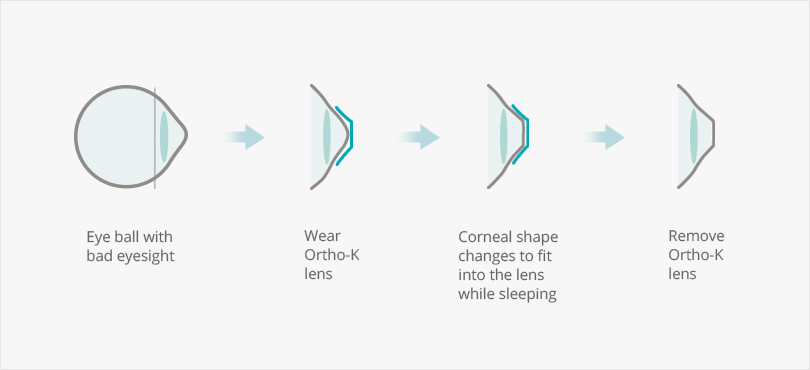Orthokeratology (Ortho-K) is becoming increasingly common in Singapore. Research indicates that children undergoing Ortho-K treatment experience a 40% to 60% reduction in the rate of myopia progression compared to those not using any myopia control methods. So, how can you determine if Ortho-K is effective for your child?
For children using myopia control spectacle lenses like Stellest or MiYOSMART, myopia progression is typically evaluated by checking their vision and prescription. At Evershine Optical, we go the extra mile by measuring their axial length (eyeball length) to monitor myopia progression.
However, the approach differs for Ortho-K; relying solely on prescription measurements is insufficient to assess the effectiveness of the treatment for your child.
How do we know if Ortho-K is effective for your child
During each Ortho-K follow-up session, we assess your child’s vision to monitor any changes in their myopia. With our lens fitting techniques, we typically aim for their prescription to be zero by the end of the day.
However, it’s important to note that their vision can still appear very good even if their prescription has increased. This is because the changes in prescription can be somewhat masked by the effects of Ortho-K treatment.
Simply checking the prescription is not sufficient to confirm any actual myopia changes.
We have been monitoring one of our Ortho-K patients for a year, and here’s what we discovered.
1 Year Review on Ortho K
In September 2022, a 10-year-old female patient began Ortho-K treatment for myopia, initially measured at -1.00 in both eyes.
Follow-Up Assessments
3-Month Follow-Up:
During the three-month follow-up, we evaluated her vision, which was excellent at 6/6. Additionally, we used our new ZEISS IOLMaster 500 to take her first axial length measurement, setting a baseline to monitor her myopia progression.
Measuring axial length is the gold standard for monitoring myopia progression in Ortho-K treatment, as any increase may indicate worsening myopia.
6-Month Follow-Up:
At the six-month follow-up, we observed an increase in her axial length by 0.08 mm in both eyes. While this indicates some growth, it falls within the normal range for eye development. Therefore, we decided to continue monitoring her at the next visit.
1-Year Follow-Up:
At the one-year follow-up, we noted a further increase in axial length—0.24 mm in the right eye and 0.23 mm in the left. Despite her stable vision, we suspected her myopia had worsened, as the axial length growth exceeded the normal range.
As a result, we decided to pause her Ortho-K lens wear for a few weeks and re-assess her prescription.
Final Assessment
After 2-3 weeks of discontinuing lens wear, we checked her prescription again and confirmed an increase in myopia: -0.75 in the right eye and -1.00 in the left eye.
The table below shows the changes in her axial length (eyeball length) from her 3-month Ortho-K follow-up:
| Follow-up Visit | Right Eye’s Eyeball Length (Axial Length) | Left Eye’s Eyeball Length (Axial Length) |
| 3 Months follow-up | 23.39mm | 23.44mm |
| 6 Months follow-up | 23.47mm | 23.52mm |
| 1 Year follow-up | 23.63mm | 23.68mm |
Key Insights
Throughout this year of Ortho-K treatment, changes in her axial length were the first indicators of myopia progression, even though her vision remained good. If we had relied solely on her visual acuity, we might not have detected the increase in myopia early, leading us to mistakenly assume that her current Ortho-K lenses were effective.
Thanks to the axial length measurements, we were able to identify her rapid eye growth, allowing us to reassess her myopia sooner, preventing further progression and switch her to a different type of Ortho-K lens to better manage her myopia.
Importance of Eyeball Length in Ortho-K Treatment
When managing Ortho-K treatment, it’s crucial not to rely solely on your child’s vision to determine if myopia is increasing or if Ortho-K is effective. While the cornea is reshaped and your child’s prescription changes during treatment, the axial length—reflecting the actual growth of the eyeball—remains unaffected.
Therefore, measuring your child’s axial length at every follow-up is essential for accurately monitoring myopia progression and evaluating the effectiveness of Ortho-K treatment.
Ortho-K at Evershine Optical
Not all practices offering Ortho-K conduct axial length measurements. At Evershine Optical, we measure your child’s eyeball length using the ZEISS IOLMaster 500 if they are undergoing myopia control treatments, such as Ortho-K, Stellest, MiYOSMART, and more.
With these axial length measurements, we can more effectively monitor your child’s myopia progression, particularly during Ortho-K treatment.
Come in and talk to us about ortho k for your child. Your child can go through an ortho k evaluation consultation to find out if he or she is suitable for ortho k treatment to slow down myopia progression. If they are not suitable, other myopia control options will be recommended.
References
- Long-Term Efficacy of Orthokeratology to Control Myopia Progression. 2023. National Library of Medicine.


